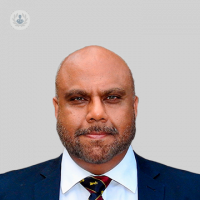How are inguinal hernias diagnosed?
Written by:Top Doctors recently spoke to highly regarded and experienced general surgeon, Mr Parv Sains, to find out the most common causes of inguinal hernias, how they are typically diagnosed, and whether or not these types of hernias can be prevented.

What are inguinal hernias?
Inguinal hernias, also known as groin hernias, occur in a part of the normal anatomy called the inguinal canal. This is a passageway from the inside of the abdomen to the outside. In males, the inguinal canal carries the testicular cord to the testicles, and in females, it carries the round ligament of the uterus.
What causes inguinal hernias?
Raising the intraabdominal pressure over a long period, or a short, sudden increase in pressure, can expose a weakness in the inguinal canal. This causes bulging of tissue (fat or bowel) from one body cavity to another. In inguinal hernias, the bowel or fat bulges through the inguinal canal.
Who is at risk of getting an inguinal hernia?
Inguinal hernias affect both men and women. Males are affected more than females.
How are inguinal hernias diagnosed?
Inguinal hernias are diagnosed, initially, through the symptoms presented. These include a bulge in the groin area, discomfort or a feeling of pressure or dragging in the groin, as well as pain in the groin when straining and lifting. There may also be a burning sensation in the groin or the middle part of the thigh.
When examined by a doctor, a swelling, which usually expands on coughing, can be felt in the groin. It is common, at this point, to confirm the diagnosis with an ultrasound scan, and, occasionally a CT or MRI scan if the diagnosis is uncertain.
Can inguinal hernias be prevented? If so, how?
Some inguinal hernias cannot be prevented. These are the ones in which there is a weakness in the groin from birth. Prevention of chronic straining as well as correct methods of lifting during work or exercise are important. Keeping fit and exercising to avoid obesity also reduces the risk.
How are inguinal hernias treated?
Inguinal hernias can be treated by a ‘watch and wait’ policy where no operation takes place. However, there are risks of enlargement of the hernia, which may then cause more symptoms of pain and discomfort that may possibly reduce mobility and interfere with daily activities and work. More seriously, the hernia and its contents can become stuck (incarceration or strangulation) and, in this case, can require emergency surgery.
The standard treatment for inguinal hernias is an operation to repair the defect or hole that the hernia is bulging through, and is performed with a mesh. The operation is either open or keyhole and is usually a day-case procedure that takes an hour or so to complete, usually, under general anaesthesia.
If you are worried that you may have an inguinal hernia, make sure to contact Mr Parv Sains today via his Top Doctors profile to book an appointment with him.


